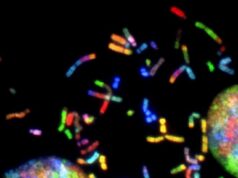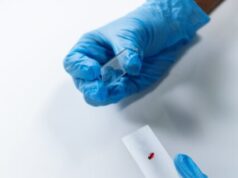Bottom left: the researcher tickling the belly of a rat. Bottom right: activity of trunk somatosensory cortex (thin vertical black lines) during belly tickling (beige box). Credit: Ishiyama & Brecht
A new study from Humboldt-Universität zu Berlin has found how “ticklishness” is represented in the rat brain.
Of all physical sensations, ticklishness is perhaps the most mysterious. Why do we laugh in response to tickling? Why are certain body parts more ticklish? Why can we not tickle ourselves? Indeed, the mystery of ticklish perception has been discussed for more than two millennia by great intellectuals including Aristotle and Charles Darwin. Despite such long-standing interest, the mechanism of ticklishness remained elusive.
The new study investigated tickling in rats. Earlier work had shown that young rats respond with 50 kHz ultrasonic “laughter-calls” to tickling by humans. In the novel study rats also reacted enthusiastically to the tickling: they emitted numerous calls. As judged by their calls, rats were most ticklish on the belly and underneath their feet. Rats often performed unsolicited joy jumps after tickling, a behavior that can be seen in joyful subjects in various mammalian species. Rats also played with the researcher’s hand and chased it, and emitted similar calls during play.
Is ticklishness a trick of the brain that rewards interacting?
The researchers (Shimpei Ishiyama & Michael Brecht) then went on to investigate the response of the rat’s brain to such tickling. Specifically, the investigators studied the rat’s somatosensory cortex, a large brain structure that contains an ordered representation of the body and handles stimuli on the body. In the trunk region of the somatosensory cortex, the researchers observed nerve cells that responded strongly to tickling. Interestingly, the researchers found very similar brain responses during play behaviours as during tickling, even though the rats were not touched by the scientist. Making rats anxious — which reduces ticklishness – also reduced the activity in these cells and suppressed the calls. Remarkably, rats emitted calls just to electric stimulation of the cells in the trunk region of the somatosensory cortex without being tickled. Taken together, these results suggest that activity in the trunk somatosensory cortex represents ticklish sensation.
Find your dream job in the space industry. Check our Space Job Board »
Professor Michael Brecht, who led the study, says: “The data much look like we identified the ticklish spot in the rat brain. I also find the similarity of brain responses to tickling and play remarkable. Perhaps ticklishness is a trick of the brain that rewards interacting and playing.”
Source: Humboldt-Universität zu Berlin
Research Reference:











